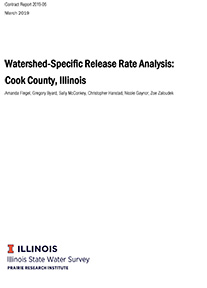Urban development is typically accompanied by an increase in impervious area that can
lead to increased runoff and more severe flooding. Stormwater retention and detention policies
are commonly employed by regulatory agencies to mitigate these potential development impacts
within their jurisdiction. This project examines the hydrologic and hydraulic impacts of such policies in the Greater Chicago region. In Phase I of this project, ISWS-CHAMP in consultation with the Metropolitan Water Reclamation District (MWRD) outlined steps to compute watershed specific release rates for two pilot study areas in Cook County. In Phase II, this methodology was then applied to other District watersheds. Phase III of the project examines the impacts of these regulations from the lens of social equitability, multi-jurisdictional watershed management, and stormwater quality.
Watershed-Specific Release Rate Analyses:
Phase I and II Analysis Report (PDF)
- Methodology
- Criteria for Analysis of Release Rates
- Upper Salt Creek Watershed-Specific Release Rate Analysis
- Calumet Sag Watershed-Specific Release Rate Analysis
- Poplar Creek Watershed-Specific Release Rate Analysis
- North Branch Watershed-Specific Release Rate Analysis
- Little Calumet Watershed-Specific Release Rate Analysis
- Des Plaines River Watershed-Specific Release Rate Analysis
- Summary of Results
Phase III Analysis Report (PDF)
- Chapter 1: Impacts of Watershed-Specific Release Rates on Disproportionately Impacted Communities
- Chapter 2: Impacts of Watershed-Specific Release Rates in Collar Counties
- Chapter 3: Stream Channel Dynamics in Urban Settings: A Literature Review
- Chapter 4: Biogeochemical Processes in Stormwater Best Management Practices
- Chapter 5: Relations between Watershed Management Strategies and Stream Erosion, Turbidity, and Sedimentation: A Literature Review
- Chapter 6: Impact of Volume Control and Detention Practices on the Groundwater of Cook County
- Chapter 7: Evaluating Stormwater Management Policies’ Effects on Water Quality
- Chapter 8: Watershed Pilot Analysis




